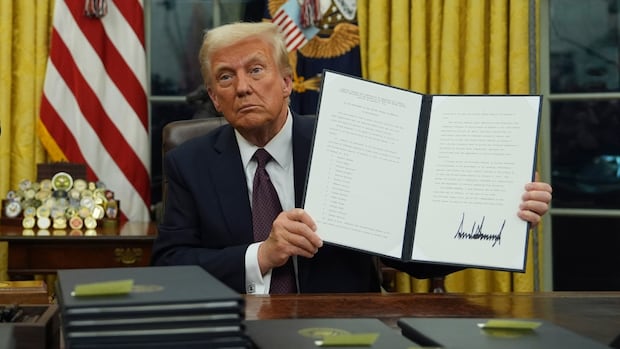Understanding Executive Orders: How Presidential Power Works

Understanding Executive Orders: How Presidential Power Works. Discover more detailed and exciting information on our website. Click the link below to start your adventure: Visit Best Website. Don't miss out!
Table of Contents
Understanding Executive Orders: How Presidential Power Works
Executive orders. The very phrase conjures images of sweeping presidential power, shaping national policy with the stroke of a pen. But what exactly are executive orders, and how do they fit into the complex framework of American governance? This article delves into the intricacies of executive orders, explaining their power, limitations, and lasting impact on American society.
What is an Executive Order?
An executive order is a directive issued by the President of the United States that manages operations of the federal government. It's essentially a legally binding instruction from the President to the executive branch agencies, outlining how they should conduct certain aspects of their work. Unlike laws passed by Congress, executive orders don't require Congressional approval. This inherent power is derived from Article II of the Constitution, which vests the President with "the executive Power." However, the scope of this power has been a subject of ongoing debate throughout American history.
The Power and Scope of Executive Orders
The power of an executive order lies in its ability to bypass the often lengthy and complex legislative process. This allows presidents to act quickly and decisively on matters they deem crucial. Historically, executive orders have been used for a wide variety of purposes, including:
- Implementing laws passed by Congress: Executive orders often clarify and operationalize newly enacted legislation.
- Creating new government agencies or programs: Examples include the creation of the Environmental Protection Agency (EPA) and numerous other agencies.
- Directing federal agencies to take specific actions: This can range from environmental regulations to national security directives.
- Establishing national priorities and goals: Executive orders frequently set the tone and direction for national policy.
Limitations on Executive Power
While seemingly powerful, executive orders are not without limitations. These include:
- Judicial Review: The Supreme Court can review and overturn executive orders deemed unconstitutional. Numerous historical cases highlight this crucial check on presidential authority. Understanding the potential for judicial review is key to understanding the true scope of executive orders.
- Congressional Oversight: Congress can exert influence by defunding programs established by executive orders or passing legislation that directly contradicts them. This ongoing tension between the executive and legislative branches is a defining feature of American governance.
- Subsequent Presidential Actions: Future presidents can revoke or modify executive orders issued by their predecessors, demonstrating the fluid nature of executive power.
- Public Opinion: Significant public backlash can pressure a president to reconsider or rescind an executive order.
Famous Examples of Executive Orders
Throughout history, several executive orders have had a profound impact on American society. These include:
- Executive Order 9066 (1942): This controversial order led to the internment of Japanese Americans during World War II. It serves as a stark reminder of the potential for abuse of executive power.
- Executive Order 13769 (2017) – “Protecting the Nation from Foreign Terrorist Entry into the United States”: This order, commonly known as the "travel ban," sparked widespread protests and legal challenges.
- Executive Order 13693 (2015) – Establishing the Task Force on 21st Century Policing: This order demonstrates a more positive use of executive power, addressing important issues of police reform.
Understanding the Impact
Understanding executive orders is crucial for any informed citizen. By grasping their power, limitations, and historical context, you can better analyze current events and engage in informed political discourse. Staying informed about new executive orders and their potential implications is essential for participating in a healthy democracy. Learn more about current executive orders by visiting the official White House archives. (Link to White House archives here)
Keywords: Executive Order, Presidential Power, US Government, Executive Branch, Presidential Directives, Constitutional Law, Political Science, White House, Policy, Legislation, Supreme Court, Judicial Review, Congressional Oversight.

Thank you for visiting our website wich cover about Understanding Executive Orders: How Presidential Power Works. We hope the information provided has been useful to you. Feel free to contact us if you have any questions or need further assistance. See you next time and dont miss to bookmark.
Featured Posts
-
 Davos 2024 L Angoisse Est Palpable Les Americains Cherchent Des Solutions
Jan 24, 2025
Davos 2024 L Angoisse Est Palpable Les Americains Cherchent Des Solutions
Jan 24, 2025 -
 Mayor Bowsers Public Appearances January 24th 2025
Jan 24, 2025
Mayor Bowsers Public Appearances January 24th 2025
Jan 24, 2025 -
 Rick Caruso Criticizes La Citys Handling Of Wildfires
Jan 24, 2025
Rick Caruso Criticizes La Citys Handling Of Wildfires
Jan 24, 2025 -
 Descompresion Lakers Analisis Del Declive Y El Camino A La Recuperacion
Jan 24, 2025
Descompresion Lakers Analisis Del Declive Y El Camino A La Recuperacion
Jan 24, 2025 -
 Arsenal Dinamo Zagreb Live Uefa Champions League Match Updates
Jan 24, 2025
Arsenal Dinamo Zagreb Live Uefa Champions League Match Updates
Jan 24, 2025
Latest Posts
-
 Deckee App Yanchep News On Dfes And Marine Rescue Wa Collaboration
Feb 05, 2025
Deckee App Yanchep News On Dfes And Marine Rescue Wa Collaboration
Feb 05, 2025 -
 Adrianne Baums Impact On Contemporary Art A Critical Analysis
Feb 05, 2025
Adrianne Baums Impact On Contemporary Art A Critical Analysis
Feb 05, 2025 -
 Is Puto Offensive A Sensitivity Guide To Its Usage
Feb 05, 2025
Is Puto Offensive A Sensitivity Guide To Its Usage
Feb 05, 2025 -
 C Battery Recycling A Guide To Responsible Disposal
Feb 05, 2025
C Battery Recycling A Guide To Responsible Disposal
Feb 05, 2025 -
 Sam Newman Fresh Allegations Surface Regarding Blair Interview
Feb 05, 2025
Sam Newman Fresh Allegations Surface Regarding Blair Interview
Feb 05, 2025
